Learning park tricks can be intimidating, but it’s easier than you think with the right approach. Focus on these 7 beginner-friendly moves to build confidence and skills:
- Straight Air: Your first jump. Stay balanced, land smooth.
- Ollie: Pop into the air using your body mechanics - no jump needed.
- 180 Spin: Rotate 180° and land riding switch. A stepping stone to bigger spins.
- Grab (Indy or Tail): Add flair to your jumps by grabbing your skis mid-air.
- 50/50 on a Box: Slide straight across a box with balanced weight.
- Press (Nose or Tail): Shift your weight to lift one end of your skis.
- Butter: Glide and pivot on your ski tips or tails for a stylish turn.
Why Snowfeet Gear Stands Out
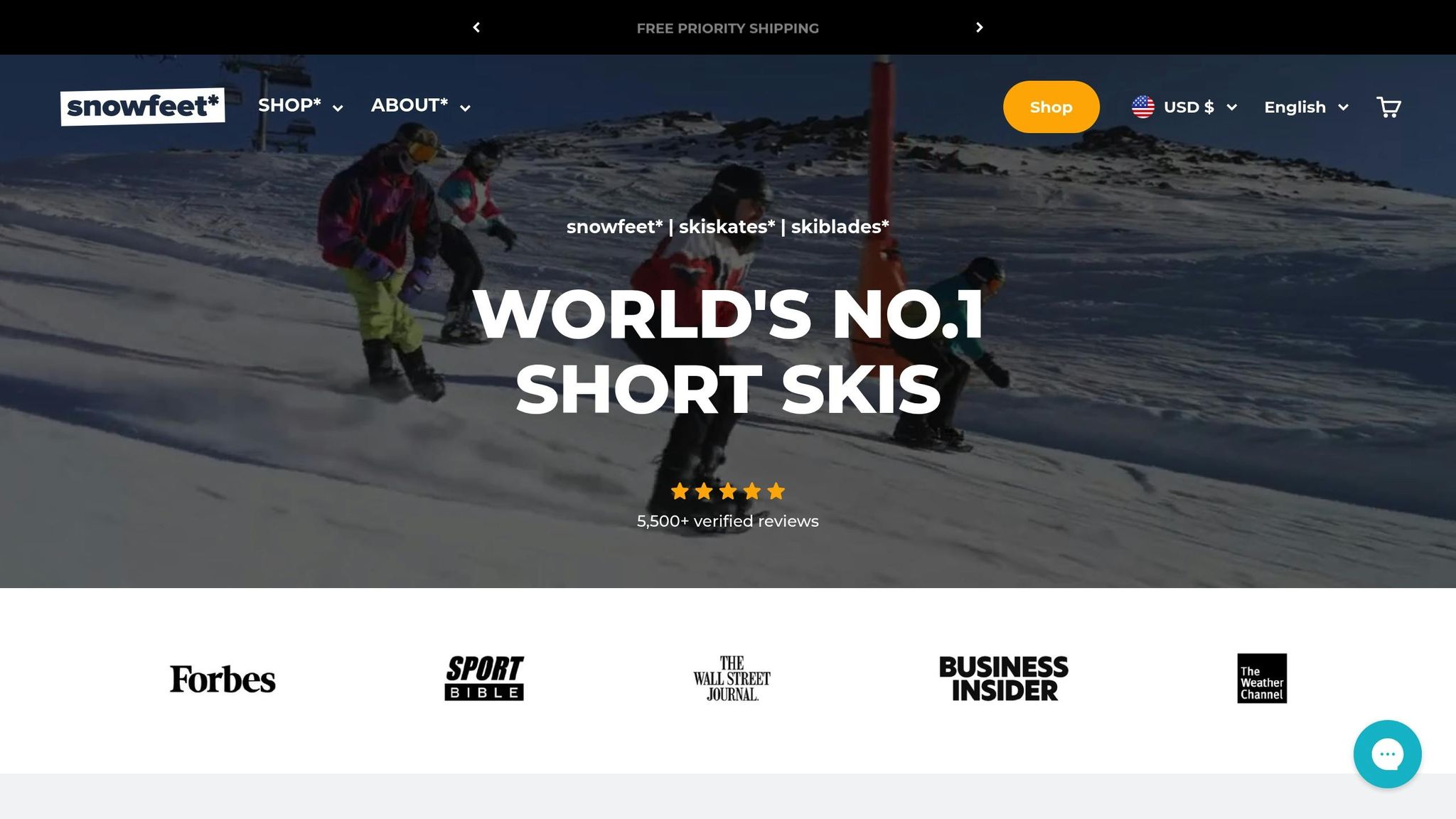
Snowfeet’s short, lightweight skis make these tricks easier to learn. They’re compact, responsive, and compatible with regular winter boots - perfect for beginners looking to progress faster without bulky equipment.
Quick Tips:
- Always wear a helmet and pads for safety.
- Start small - low jumps, wide boxes, and gentle slopes.
- Practice basic moves like weight shifts and small hops on flat ground.
- Use Snowfeet gear for better control and quicker skill-building.
Whether it’s your first jump or a stylish butter, these tricks will get you started in the park. Take it step by step, enjoy the process, and have fun! :)
First 10 Things To Learn as a Beginner in the Park
Safety and Preparation Basics
Before you start hitting rails or attempting spins, make sure you're geared up with proper safety equipment. The most important piece? A certified helmet. Terrain parks come with risks, and even small jumps can lead to head injuries. Adding wrist guards, knee pads, and elbow pads might feel cumbersome, but they can save you from serious scrapes and bruises when you take a tumble.
Knowing terrain park etiquette is just as crucial as wearing the right gear. Always check uphill before dropping into a feature, and avoid sitting or hanging out on landings or takeoffs. If you fall, clear out of the way quickly to keep others safe. Start small - those 2–3-foot jumps and boxes might look easy, but they’re ideal for building muscle memory without the added danger of bigger features.
Once you’ve got safety and etiquette down, it’s time to warm up properly. This is where Snowfeet* products shine. Unlike traditional long skis from brands like Atomic or Völkl, which need wide, sweeping turns to gain speed, shorter skis let you work on quick edge changes and balance drills in tighter spaces. Spend 10–15 minutes on flat ground practicing essential moves: a balanced stance, weight shifts, small hops, and 180-degree turns. With Snowfeet* Skiblades or Skiskates, these movements feel smoother and more controlled compared to the longer, stiffer skis made by brands like Dynastar or Elan.
When you’re ready to start, head to the beginner section of the terrain park. Most parks have small rollers, jumps under 5 feet, and low, wide boxes - the perfect setup for learning. Begin by riding straight over these features without attempting tricks. Focus on staying balanced and using your knees to absorb the landings.
Before your first run, double-check your gear. Ensure your Snowfeet* bindings are adjusted correctly and that your boots fit snugly without pinching. The compact design of Snowfeet* may reduce strain during falls, but having a secure fit is still key for both control and comfort.
Progress takes patience. While Snowfeet* make it easier to learn compared to traditional long skis, improvement still comes with practice. With the right safety measures and preparation in place, you’ll be set to approach each feature with confidence.
1. Straight Air
Straight air is all about hitting a jump, getting airborne, and landing smoothly. It’s the most basic trick in the terrain park, but don’t let that fool you - it’s an essential building block for mastering park skills. It teaches you the fundamentals of balance, control, and clean landings.
Why It's Great for Beginners
If you’re new to terrain parks, straight air is your best friend. It’s the simplest and safest trick to start with, perfect for anyone who’s never tackled a jump before. Since there are no spins or grabs involved, you can focus entirely on staying balanced and landing with control. Nail this, and you’ve got a solid base for learning more advanced tricks down the line.
How Snowfeet* Products Help
Here’s where Snowfeet* Skiblades and Skiskates come in handy. Their shorter length and lighter design make them easier to handle compared to traditional skis. This means quicker mid-air adjustments and softer, more forgiving landings - ideal for beginners who might feel intimidated by longer skis. With Snowfeet*, even small weight shifts translate into smoother corrections, helping you feel more in control as you learn.
Building Core Skills
Straight airs aren’t just a beginner move - they’re a key part of developing terrain park basics. They help you get comfortable with reading jumps, gauging your speed, and sticking safe landings. These are skills you’ll rely on for every trick you try, no matter how advanced you get. Plus, even experienced riders use straight airs as a warm-up to get into the groove.
Confidence and Progression
Mastering straight airs builds confidence and sharpens your air awareness. The key? Stay centered, keep your eyes ahead, and relax your arms. Repetition is your best friend here. The more you practice, the more natural it will feel, paving the way for spins, grabs, and other tricks.
Before you try, always check the jump and landing area to make sure it’s safe. Start small - stick to the beginner section and work your way up to bigger jumps as your confidence grows. With Snowfeet* products, this progression feels easier since their compact size requires less effort on the approach compared to traditional skis.
Once you’ve got straight airs down, you’ll be ready to tackle the Ollie and take your freestyle skills to the next level.
2. Ollie
The ollie is a key freestyle move that lets you pop into the air without needing a jump. It’s all about using your body mechanics to lift off the ground. Once you’ve nailed the ollie, you’ll have the foundation for tons of tricks and the confidence to tackle terrain parks with flair.
Why Beginners Should Start Here
Ollies are beginner-friendly because you don’t need any special park features to practice them. You can work on them just about anywhere - flat ground or gentle slopes are perfect. Plus, they’re a great way to build your timing and body positioning skills without having to take on big jumps or intimidating features.
The movement is simple: shift your weight forward, snap back, and lift your knees to get airborne. Since you’re in full control, you don’t have to worry about things like speed or approach angles that come with jump-based tricks.
Learning Ollies with Snowfeet* Products
Snowfeet* gear makes learning ollies a breeze. Their Skiblades and Skiskates are shorter and lighter than traditional skis, meaning they’re much easier to handle. That compact design reacts instantly to your movements. When you shift your weight and snap into the ollie motion, the Snowfeet* gear responds right away - no lag, no fuss.
Compare that to traditional skis from brands like Rossignol or K2, which are designed for stability over long distances. They’re heavier and require more effort and precision to pull off an ollie. Snowfeet* Skiblades and Skiskates, which measure just 44–65 cm (around 17–26 inches), let you focus on your technique rather than wrestling with bulky equipment.
Building Terrain Park Basics
Ollies are the building blocks for almost every advanced terrain park trick. They teach you how to generate lift, control your body in mid-air, and stick a balanced landing. Those skills directly translate to tricks like spins, grabs, and rail slides.
Practicing ollies also helps you develop air awareness - an essential skill for more complex maneuvers. Once you’ve got the basics down, you’ll be ready to move on to spins and grabs with confidence.
Unlocking Your Progression
The potential for growth with ollies is huge. Once you’ve mastered the basics, you can start experimenting with variations like nollie ollies (where you pop off the nose instead of the tail) or add in 180-degree spins. You can also use ollies to hop over small obstacles, navigate tight spots, or simply add some flair to your skiing.
Start small by practicing little hops and focusing on landing centered. As you gain confidence, add more snap to your movement. Snowfeet* products make this progression feel natural - their lightweight, responsive design means that more effort equals more height, without the delayed reaction you’d get with traditional skis.
Try practicing ollies in different snow conditions. They’re great on groomed runs, but tackling them in powder or uneven snow can teach you to adapt your technique and build versatility for all kinds of terrain park challenges.
3. 180 Spin (Frontside or Backside)
A 180 spin is exactly what it sounds like - rotating 180° to land riding switch (backward). It’s a step up from ollies and introduces you to the world of rotational tricks. You can choose between frontside or backside spins, each offering a slightly different feel and challenge.
Why Beginners Should Try It
The 180 spin is perfect for beginners looking to dip their toes into rotations. It’s a natural progression after mastering straight airs and ollies. The best part? You don’t need big jumps or insane speeds to get started. Small, controlled movements are enough to help you get the hang of it. Plus, it’s a great way to build confidence and develop spatial awareness in the air.
Unlike a full 360, which can feel overwhelming, the 180 gives you just enough rotation to practice without getting dizzy or disoriented. It’s manageable, fun, and a solid stepping stone for future tricks.
Why Snowfeet* Makes It Easier
If you’re using Snowfeet* Skiblades or Skiskates, learning 180 spins becomes even more approachable. These compact designs are lighter and shorter than traditional skis or snowboards, making edge-to-edge transitions quicker and spins easier to initiate. Unlike long skis, which can feel sluggish and harder to control, Snowfeet* gear responds instantly to your movements.
This responsiveness helps you nail the rotation more consistently, reduces the chance of catching an edge, and gives you a more forgiving landing. It’s like having a cheat code for learning spins - perfect for building confidence and progressing faster.
A Terrain Park Essential
The 180 spin is a must-know move in the terrain park. It introduces the idea of aerial rotation and switch landings without being overly risky. Mastering it early helps you understand how to control your body while spinning and prepares you for more advanced tricks down the line.
Once you’ve got 180s dialed in, the skills transfer to bigger spins, like 360s, and even to tricks on rails and boxes. Plus, learning to ride switch - landing and continuing backward - opens up a whole new world of possibilities for your park runs.
What You’ll Gain
Landing a 180 isn’t just about pulling off one trick - it’s about building a toolkit of essential skills. You’ll improve your spatial awareness as you track your rotation and sharpen your upper body control by leading the spin with your shoulders and head. Over time, you’ll also grow more confident riding switch, effectively doubling your options for tricks.
Here’s a tip: avoid common mistakes like hesitating mid-spin, failing to lead with your upper body, or landing stiff-legged. Instead, practice on flat ground first, focus on using your shoulders and head to guide the rotation, keep your knees bent to absorb impact, and always visualize your landing.
Once you’ve got the basic 180 down, you can start experimenting. Add grabs, link multiple 180s, or use the same mechanics to work up to 360s. The 180 spin isn’t just a trick - it’s the foundation for unlocking a whole range of park moves.
4. Grab (Indy or Tail Grab)
Grabs are all about adding flair and personality to your jumps. Whether it's an Indy grab (using your back hand) or a tail grab (reaching for the tail of your gear), these moves bring a touch of style to your airtime. Plus, they’re a great way to ease into building trick confidence in the park.
Perfect for Beginners
Grabs are a beginner-friendly trick because they’re simple and don’t require a ton of airtime or complicated movements. All you need to do is get some air, reach down, hold your gear, and land. Unlike spins or flips, grabs keep things straightforward - you take off and land facing forward, which helps you stay balanced and oriented.
The best part? The timing isn’t super strict. You don’t need to nail a perfect rotation or worry about a tricky landing. Just bend your knees, get airborne, grab your gear, and stick the landing. Most beginners can start trying grabs after a few successful jumps, making them an easy and approachable first step into terrain park tricks.
Why Snowfeet* Gear Makes It Easier
Snowfeet* gear is a game-changer for learning grabs. Its compact and lightweight design makes it much easier to lift your legs and reach for your gear compared to traditional skis. With less bulk to maneuver in the air, grabbing the tail or center of your equipment feels much more natural.
Thanks to its quick responsiveness, Snowfeet* gear also helps you maintain control over your body position, making it easier to time your grabs. Many beginners find that after just a few sessions with Snowfeet* gear, they’re confidently pulling off Indy and tail grabs on small jumps. This quick progress inspires them to experiment with other grab variations and build their skills even further.
A Foundation for Terrain Park Skills
Grabs are a key building block in terrain park progression. Once you’ve mastered the basics like straight airs, ollies, and spins, grabs are often the first "style" trick riders learn. They teach you how to control your gear in the air, a skill that translates directly to more advanced park features like rails, boxes, and bigger jumps.
In the terrain park world, a clean grab isn’t just about looking cool - it’s a sign of control and growing expertise. By incorporating grabs into your routine, you’re not only elevating your style but also setting yourself up for success with more advanced tricks.
Building Skills That Last
Practicing grabs helps develop essential skills like air awareness, balance, and coordination. These are the building blocks for tackling more complex tricks down the road. With Snowfeet* gear, you’ll find it easier to refine your grabs and transition into advanced moves like grabbed spins or technical variations. The muscle memory and spatial awareness you gain from practicing grabs will be invaluable as you progress.
Grabs also teach you one of the most important aspects of park riding: landing safely. Releasing the grab at the right time trains you to absorb impact and extend your legs properly, which becomes crucial as you start hitting larger features.
Start small - practice on flat ground to get comfortable with bringing your knees up and reaching for your gear. Then move on to small jumps or rollers, focusing on the timing of your grab. Snowfeet* gear’s forgiving design makes this process smoother, helping you build confidence and style as you level up in the terrain park.
5. 50/50 on a Box
The 50/50 is one of the first tricks most riders learn when exploring rail or box features in terrain parks. It’s a simple move: you slide straight across a box or rail with both skis evenly balanced. The name "50/50" comes from the fact that your weight is evenly distributed - 50% on each ski - as you glide across. Think of it as the foundation for more advanced park tricks.
How to Nail the 50/50
Sliding a box requires steady balance and control. Here’s the basic rundown: approach the box at a moderate speed, ride up onto it, keep your skis straight and parallel, and slide off the end. The trick here is keeping your weight centered throughout the slide - lean too far forward or back, and you’ll lose your balance.
Why Boxes Are Beginner-Friendly
Boxes are a great starting point for beginners because they’re wide, stable, and forgiving compared to narrow rails. Beginner boxes are usually low to the ground, which makes it easier to recover from small mistakes without taking a hard fall.
The beauty of the 50/50 is its simplicity. There’s no need for spins, grabs, or jumps - just focus on staying balanced and sliding straight. This straightforward approach helps build confidence and teaches you the fundamentals of jibbing without overwhelming you. Most beginners can attempt a 50/50 within their first few sessions in the terrain park, and even if you slip up, the low speed and wide surface make it a safe trick to practice.
Snowfeet* Gear Makes It Easier
Snowfeet* gear can make learning the 50/50 even smoother. Traditional skis, which are typically 150-180cm long, can sometimes catch on the edges of features, leading to awkward falls. With Snowfeet*, the shorter, lighter design gives you more control and makes balance adjustments quicker and easier.
Because they’re compact and lightweight, you’re less likely to feel “dragged” by momentum if you start to lose balance. Plus, the shorter length makes it easier to keep an eye on both ends of your gear, helping you stay centered on the box.
Building Terrain Park Basics
The 50/50 isn’t just a beginner trick - it’s the building block for almost every rail and box maneuver in the park. Once you’ve got it down, you can start experimenting with more advanced moves like boardslides, lipslides, and even spinning onto or off of features.
Learning the 50/50 also teaches you how to approach terrain park features with the right speed. Go too fast, and you might overshoot the box or lose control. Go too slow, and you won’t make it across. Mastering this balance between speed and control is a skill that carries over to more advanced tricks.
And don’t forget - box skills complement the air tricks you’re learning on jumps. While jumps improve your awareness in the air and landing technique, boxes help you develop balance, edge control, and the ability to stay composed under pressure. Together, these skills form a solid foundation for terrain park riding.
Why It’s Worth Practicing
Practicing 50/50s isn’t just about learning a trick - it’s about building muscle memory and balance that will improve your overall skiing. The core strength and ankle stability you develop while sliding boxes will help you handle challenging conditions on the slopes, like icy patches or moguls. Plus, landing your first successful box slide is a huge confidence booster and opens the door to a whole new world of terrain park fun.
Start small. Find the widest, lowest box in the park and focus on sliding straight across without any extra moves. Practice your approach on flat ground first - get comfortable with the stance and visualize the entire sequence, from riding onto the box to sliding off the end. Thanks to the forgiving nature of Snowfeet* gear, this process feels less intimidating and more manageable compared to traditional skis.
Once you’ve mastered the 50/50, you’ll be ready to take on more advanced rail tricks and expand your terrain park skills. It’s all about building confidence, one slide at a time.
sbb-itb-17ade95
6. Press (Nose or Tail)
A press is one of the coolest beginner tricks you can try in the terrain park. The idea is simple: shift your weight forward for a nose press or backward for a tail press, lifting the opposite end of your skis off the snow while keeping your balance. Think of it like a skateboard manual, but on snow - riding on one end while the other hovers in the air.
What makes presses so fun is their versatility. You can do them just about anywhere: flat ground, small rollers, or even on boxes and rails. And unlike jumps or spins, presses keep you grounded, which makes them a great confidence booster for anyone not quite ready to catch air yet.
Why Presses Are Perfect for Beginners
Presses are beginner-friendly because they focus on the basics - balance and weight shifting - without needing complicated rotations or scary airtime. If you’ve got decent balance and can shift your weight while skiing, you’re already halfway there.
You can start practicing at your own pace, going as slow as you need to. With a little practice, most beginners can nail their first press after just a few sessions at the terrain park. And even if you lose your balance, you’re close enough to the ground to recover without much drama.
The learning process is pretty forgiving, too. Start by working on balance control, keeping your ski tips or tails elevated. Once you’re comfortable, move to gentle slopes or small park features. Unlike tricks that demand perfect timing or specific speeds, presses let you experiment and find what works best for your style.
Why Snowfeet* Make Presses Easier
If you’ve ever tried presses with traditional skis, you know how tricky it can be to shift your weight precisely. Those long skis can feel like they have a mind of their own. That’s where Snowfeet* products like Skiblades and Skiskates come in.
Snowfeet* gear is lightweight and responsive, making presses feel more natural. Lean forward for a nose press, and the tail lifts easily. Shift back for a tail press, and the nose reacts instantly. Plus, their compact size - Skiskates are just 44 cm long - makes them way less intimidating than traditional 170 cm skis. Many beginners say using Snowfeet* made learning presses feel a lot less overwhelming because the equipment is so easy to handle.
How Presses Fit Into Terrain Park Basics
Presses are like your introduction to the terrain park. They teach you how to approach features, stay balanced on different surfaces, and exit smoothly - all skills that apply to nearly every other park trick.
For example, when you press across a box, you’re learning the same approach and exit techniques you’ll need for tricks like 50/50 slides or boardslides. The balance and body control you develop with presses also come in handy for jumps, helping you maintain proper posture while in the air.
But presses aren’t just about technique - they’re about style. Terrain park riding is all about expressing yourself, and a clean nose or tail press is a great way to start thinking about how your riding looks and feels. Mastering this trick sets the stage for more creative moves down the line.
Building Skills That Go Beyond the Park
The benefits of learning presses don’t stop at the terrain park. The core strength and ankle stability you develop will improve your overall skiing, helping you tackle tough conditions like moguls, ice, or uneven snow.
Presses also teach you precise weight transfer, a skill that’s key for advanced techniques like carving or powder skiing. When you learn to shift your weight smoothly for a press, you’re building the muscle memory needed for clean carves on groomers or effortless turns in deep powder.
Balance and edge control are other big wins. Holding a press requires constant micro-adjustments to stay stable, which sharpens your body’s sense of balance. This improved body awareness translates to more confidence and control, no matter where you’re skiing.
Once you’ve mastered basic presses, you can start adding spins, grabs, or even link multiple presses for smooth park lines. Pair these tricks with the agility of Snowfeet*, and you’ll see why their compact design is such a game-changer for park riding. It’s all about building skills, having fun, and pushing your limits - one press at a time.
7. Butter
A butter is one of those smooth, stylish moves that can make you feel like a pro, even as a beginner. Picture yourself gliding over soft snow, shifting your weight just enough to lift one end of your skis and pivot effortlessly. Unlike a 180-degree spin that relies on airtime, a butter keeps you grounded, using the snow as your canvas for a graceful turn.
There are two main types of butters: nose butters, where you lean forward and pivot on your ski tips, and tail butters, where you lean back and pivot on your ski tails. Both create a fluid, flowing motion - kind of like a skateboarder’s powerslide - showcasing your ability to control weight and balance with precision.
What makes butters so fun is how easy they are to work into your runs. You can throw them in between jumps, use them to navigate flat sections, or even change direction on mellow slopes. They’re a great way to add flair to your skiing without needing big features or airtime, making them a perfect bridge between basic moves and more advanced tricks.
Suitability for Beginners
If you’re just starting out, butters are surprisingly beginner-friendly. Once you’ve nailed the basics of weight shifting, you’re already halfway there.
The best part? You’re in control of the speed and intensity. Start slow on gentle slopes where you can practice shifting your weight without worrying about going too fast. Unlike jumps or rails, you don’t need a specific feature to get started - just find a smooth patch of snow and start experimenting. Plus, since you stay close to the ground, the risk of falling feels a lot less intimidating.
Easier with Snowfeet* Gear
Traditional skis can make butters a bit tricky because of their length and the leverage required. That’s where Snowfeet* gear comes in. With their compact design - like the Snowfeet* Skiskates, which are only 44cm long - you’ll find it much easier to lift the tips or tails and pivot. The shorter length brings the pivot point closer to your body, making the movement feel natural and giving you instant feedback. Many riders even land their first butter during their first session with Snowfeet* gear, skipping the weeks of practice often needed with regular skis.
The lightweight design also makes a big difference. On longer skis, the tips or tails can sometimes swing around with too much force once you start a butter. With Snowfeet*, you get immediate control, so you can start and stop the rotation exactly when you want. If you’re looking for a bit more stability, skiblades at 65cm offer a great middle ground - easy to manage but with added balance.
Tying Butters into Terrain Park Basics
Once you’ve got the hang of butters, they open up a world of possibilities in the terrain park. Think of them as the glue that ties your tricks together. While jumps, rails, and boxes depend on specific features, butters can be done anywhere, helping you link different elements into smooth, flowing runs.
Practicing butters also sharpens essential skills like edge control, weight distribution, and timing - all of which are key when you’re hitting jumps, sliding rails, or just cruising between features. In fact, butters can even help you adjust your speed or direction in the park. Coming in too fast or at an awkward angle? A quick butter can smooth things out while adding style to your run. Advanced riders often use butters to set up their next trick or to spice up simpler sections.
Building Skills Beyond the Park
The benefits of learning butters go way beyond the terrain park. The balance and core strength you develop will improve your skiing across the board, helping you tackle challenging conditions like moguls, icy patches, or uneven snow with more confidence.
Butters also teach you how to control your edges and distribute pressure effectively - skills that are essential for carving, skiing powder, and handling all-mountain terrain. Plus, the rotational awareness you gain while buttering lays the groundwork for more advanced moves like spins, flips, and aerial tricks. Understanding how your body moves during these rotations, while staying connected to the snow, sets you up for success as you progress.
At the end of the day, butters help you flow with the mountain instead of fighting it. This smooth, adaptive approach not only transforms how you ski but also pairs perfectly with the agility and responsiveness of Snowfeet* gear. It’s a creative, expressive way to ride that makes every run more fun.
Why Snowfeet* Beat Long Skis and Snowboards for Beginners
For beginners tackling terrain parks, traditional long skis and snowboards can feel like trying to steer a cruise ship in a tight canal - bulky and hard to manage. Snowfeet* flips that script, offering a compact, responsive alternative that makes learning jumps, spins, and rail slides way less intimidating.
Maneuverability That Builds Confidence
One of the standout perks of Snowfeet* gear is how maneuverable it is. Long skis and snowboards often mean slower response times, especially during mid-air adjustments or tricky landings. Snowfeet* products, like the 44 cm Skiskates or 65 cm Skiblades, keep the action close to your center of gravity. This design gives you instant feedback and control, which is a game-changer for beginners trying to master the basics. Plus, their smaller size makes approaching your first rail or box feel far less overwhelming.
Convenience You Can Carry
Forget lugging around bulky gear that requires roof racks or oversized bags. Snowfeet* Mini Ski Skates are compact enough to fit in a backpack. This portability isn’t just convenient - it’s freeing. You can explore different slopes or even practice in unconventional spots without the hassle of traditional setups. And if you take a tumble (hey, it happens), having less gear in play makes recovery much simpler.
Here’s a quick breakdown of how Snowfeet* stacks up against traditional gear:
| Feature | Traditional Skis/Snowboards | Snowfeet* Gear |
|---|---|---|
| Length | 140–180 cm | 38–99 cm |
| Learning Curve | Longer adjustment period | Streamlined adaptation |
| Portability | Needs roof racks/big bags | Fits in a backpack |
| Maneuverability | Larger turning radius | Quick, precise response |
| Fall Recovery | Cumbersome | Easier to recover |
| Approachability | Intimidating for beginners | Beginner-friendly feel |
Designed for Park Progression
Snowfeet* gear is all about precision and control - two must-haves when you're learning to press on a box or balance during a 50/50 slide. Its lightweight design means less fatigue during long sessions, letting you focus on nailing your technique instead of wrestling with heavy equipment.
Boot Compatibility = Flexibility
Another big win? Snowfeet* works with the gear you already own. Unlike traditional setups that lock you into specific ski or snowboard boots, Snowfeet* products are compatible with regular winter shoes, snowboard boots, or ski boots. This flexibility lets you start with what you’ve got and upgrade as you improve, keeping things simple and budget-friendly.
A More Affordable Start
Speaking of budgets, traditional ski setups can be a hefty investment. Snowfeet* offers a more wallet-friendly entry point, with options like Skiskates starting at around $390. For beginners, this lower cost makes it easier to dive into terrain parks and focus on learning tricks like butters, presses, and 180 spins - without the stress of splurging on expensive gear.
Snowfeet* isn’t just gear; it’s a smarter, more approachable way to get started in the park. Whether it’s the compact size, portability, or versatility, it’s clear why so many beginners are swapping long skis and snowboards for these mini marvels.
How to Progress and Build Confidence
Learning terrain park skills is all about taking it step by step. Start small, build a strong foundation, and enjoy the ride as you progress safely and confidently.
The first step? Master the basics on flat terrain. Spend time practicing ollies, 180s, and butters in an open, gentle area. This gives you the chance to focus fully on your technique without distractions or pressure. Skipping this step is a common mistake - muscle memory takes time to develop, and these basics will set you up for success later.
Once you feel comfortable with tricks on flat ground, try small natural features like gentle rollers, tiny bumps, or the edges of groomed runs. These spots give you a feel for performing tricks with a bit more challenge, but they’re still forgiving. Think of them as your practice grounds before hitting the actual park.
When you’re ready to tackle terrain park features, look for beginner-friendly options. Most parks have sections with low boxes, small jumps, and mellow rails - perfect for easing into the experience. Even seasoned riders revisit these smaller features when learning something new. Stick to the smallest features available at first; it’s all about building confidence.
Focus on mastering one trick at a time. Make sure you can land it cleanly and consistently before moving on to the next. Trying to juggle multiple tricks at once often leads to sloppy technique and slower progress. Quality beats quantity every time.
If you’re using Snowfeet* gear, you’ll find the shorter length and responsive feel especially helpful during this phase. Whether you’re working on a press or nailing your grab timing, the quick feedback helps you identify mistakes and adjust faster than you might with traditional long skis.
Keep your sessions short and focused - 20 to 30 minutes is ideal. Take breaks to stay sharp and avoid burnout. Believe it or not, your brain processes new skills better when you give it time to rest between attempts.
Don’t forget to watch and learn from others. Many terrain park riders are happy to share tips, especially when they see you putting in the effort and respecting park etiquette. Sometimes, a small piece of advice about your body position or timing can make all the difference.
Another great tool? Filming yourself. Watching your runs can reveal things you might not notice while riding - maybe your grab isn’t as clean as you thought, or your 180 starts too early. Video feedback is a game-changer for fine-tuning your tricks.
Remember, progress isn’t always a straight line. Some days, everything clicks; other days, it feels like you’re back to square one. That’s just part of the process. Be patient and focus on the bigger picture - every small step adds up over time.
With Snowfeet* gear and a smart, gradual approach, you’ll gain confidence and improve faster than you might expect. The compact, maneuverable design makes every stage of learning feel more manageable, whether you’re working on your first ollie or finally hitting that rail you’ve been eyeing all season. Take it one step at a time, and enjoy the journey!
Conclusion
Learning terrain park tricks doesn’t have to feel overwhelming. By starting small, prioritizing safety, and gradually building your skills, you can nail these seven beginner-friendly tricks and have a ton of fun along the way.
Progress takes patience and practice. Every rider moves at their own pace, celebrating those little wins with each successful landing. Whether you’re working on your first straight air or trying to smooth out a butter, the real joy comes from the process itself.
Using gear like Snowfeet* can make things easier. Their shorter, more responsive design gives you instant feedback - perfect for dialing in a 180 spin or grab. Plus, it eliminates the hassle of bulky equipment, so you can focus on your technique instead of struggling with oversized gear.
FAQs
How can beginners maintain balance and control while learning terrain park tricks?
Mastering Balance and Control in the Terrain Park
Getting the hang of balance and control in the terrain park? It all starts with nailing the basics. Work on foundational riding skills like pivot slips and riding switch - these moves are key for boosting your overall stability. Engage your core to stay steady, and you’ll also lower your chances of taking an unexpected tumble. Oh, and don’t forget to relax - keeping your body loose, especially your ankles, helps you move more fluidly and stay in control.
When it’s time to try some tricks, keep your eyes forward or focus on feeling for grabs, rather than looking down. This small adjustment can make a big difference in staying balanced during jumps. A pro tip? Practice on flat ground first. It’s a great way to build up your confidence before diving into the park’s features.
For beginners, Snowfeet* products like skiblades and skiskates are a game-changer. Their shorter length makes them way easier to maneuver and control than traditional long skis or snowboards. That means you can pick up tricks faster and enjoy the park without feeling overwhelmed.
Why is Snowfeet gear better for beginners learning terrain park tricks compared to traditional skis or snowboards?
Snowfeet gear is a great choice for beginners who want to try out terrain park tricks. Its shorter and lightweight design makes it super easy to control and maneuver. Unlike traditional skis or snowboards that can feel bulky and a bit overwhelming, Snowfeet’s mini skis and skiblades let you make quicker turns, stick smoother landings, and feel more confident as you experiment with new moves.
Because of their compact size, Snowfeet gear takes away the steep learning curve you’d face with longer skis or snowboards. This means beginners can focus on improving their skills while enjoying the freedom and fun that comes with mastering the basics in the terrain park.
What safety tips should beginners follow before trying terrain park tricks?
Beginner Terrain Park Tips: Safety First
When you're gearing up to tackle beginner terrain park tricks, keeping safety at the forefront is key. Start with the basics and take it slow - there’s no rush to master everything at once. Before hitting any feature, give it a quick inspection to ensure it’s in good condition and suitable for your skill level.
Make sure you’re dressed for the part with proper safety gear. A helmet is non-negotiable, and adding wrist guards and impact shorts can go a long way in protecting you from unexpected falls. Beyond gear, good park etiquette is just as important. Wait your turn, be mindful of others, and avoid cutting someone off mid-run. A little respect goes a long way in keeping the park a fun place for everyone.
If you’re just starting out, Snowfeet* products like skiblades and skiskates can be a great option. Their compact size gives you better control and makes maneuvering easier compared to traditional skis or snowboards. This added control can help you build confidence and learn tricks more safely. Plus, they’re just plain fun to use, making your time on the snow even more enjoyable.







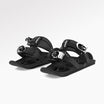













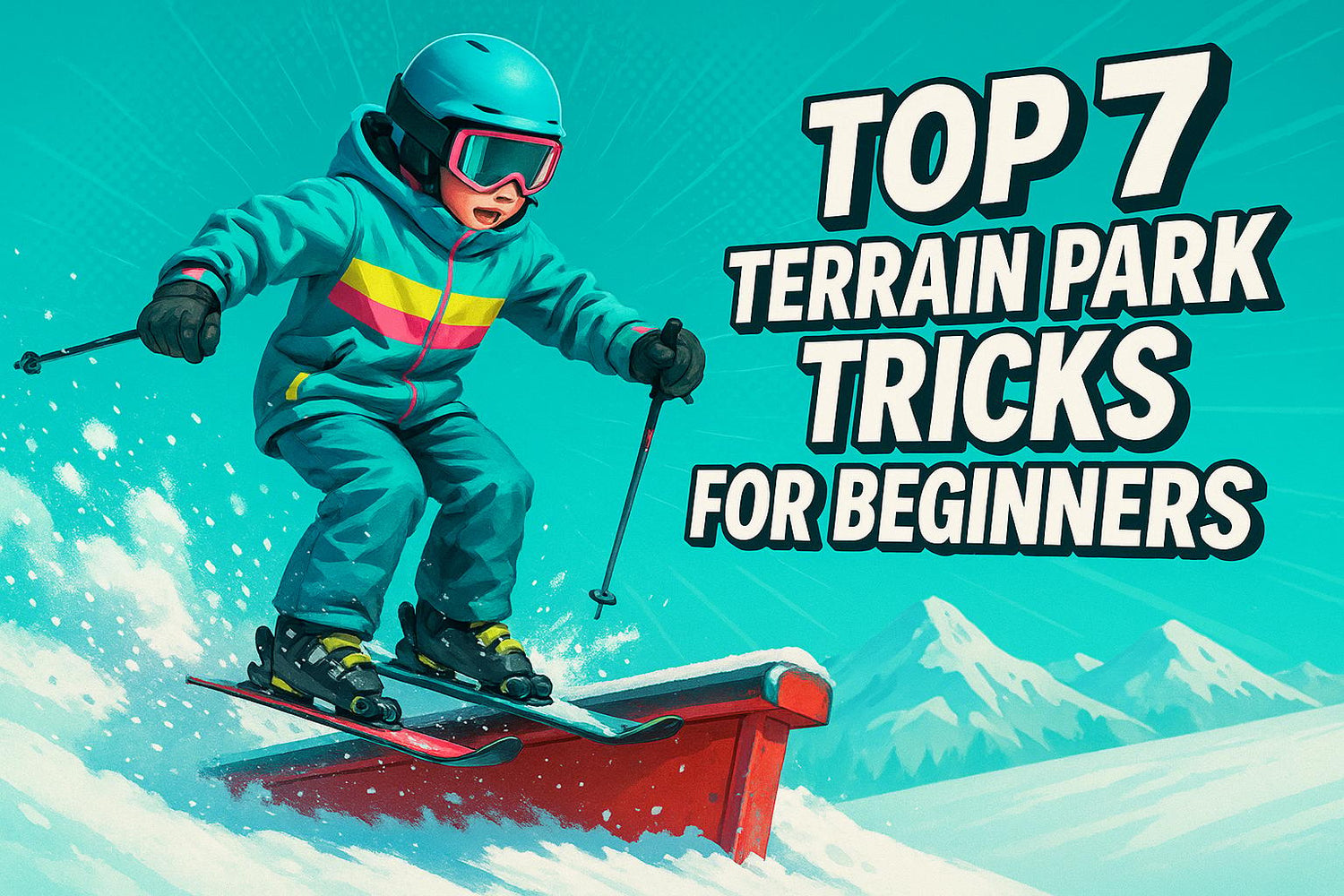
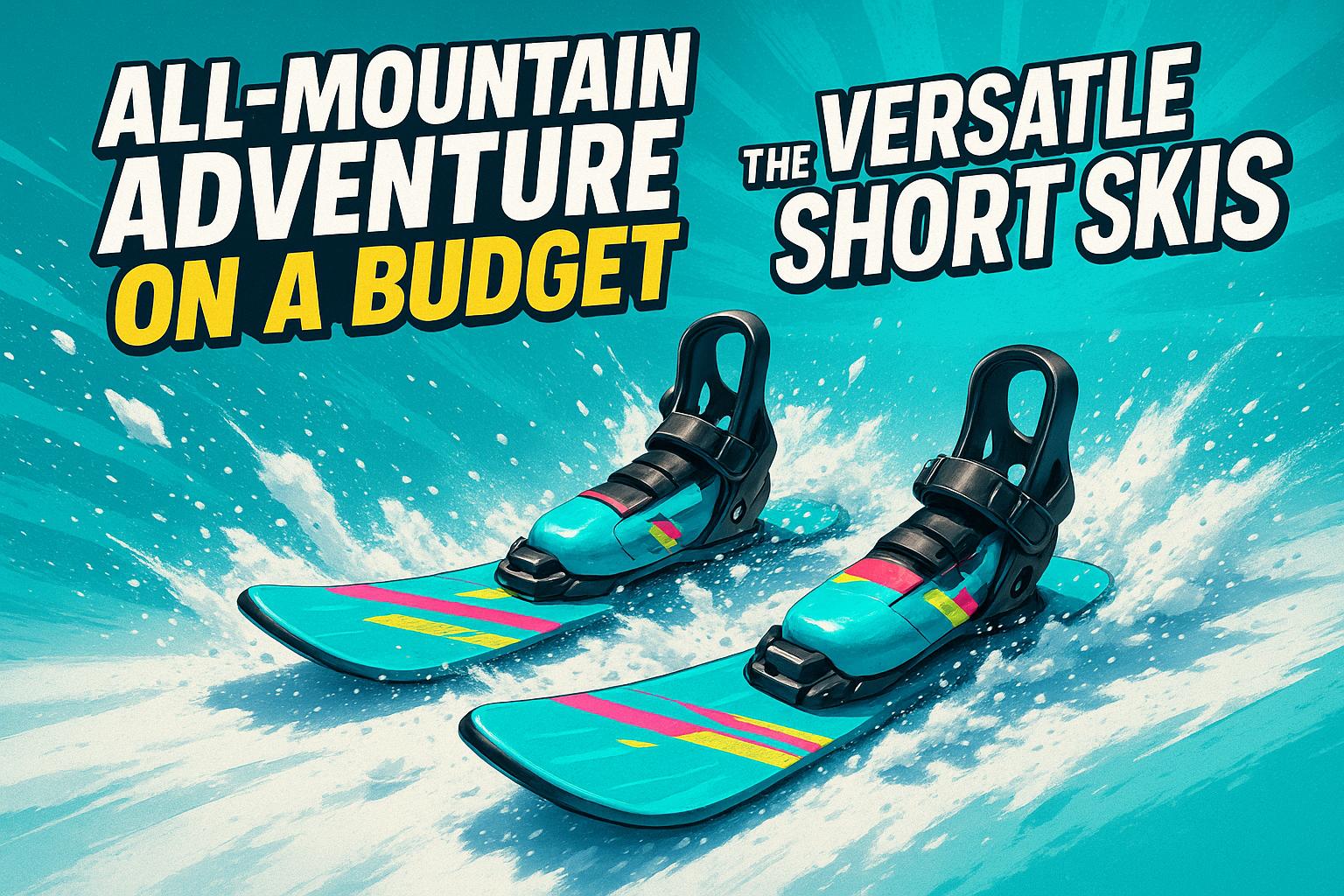
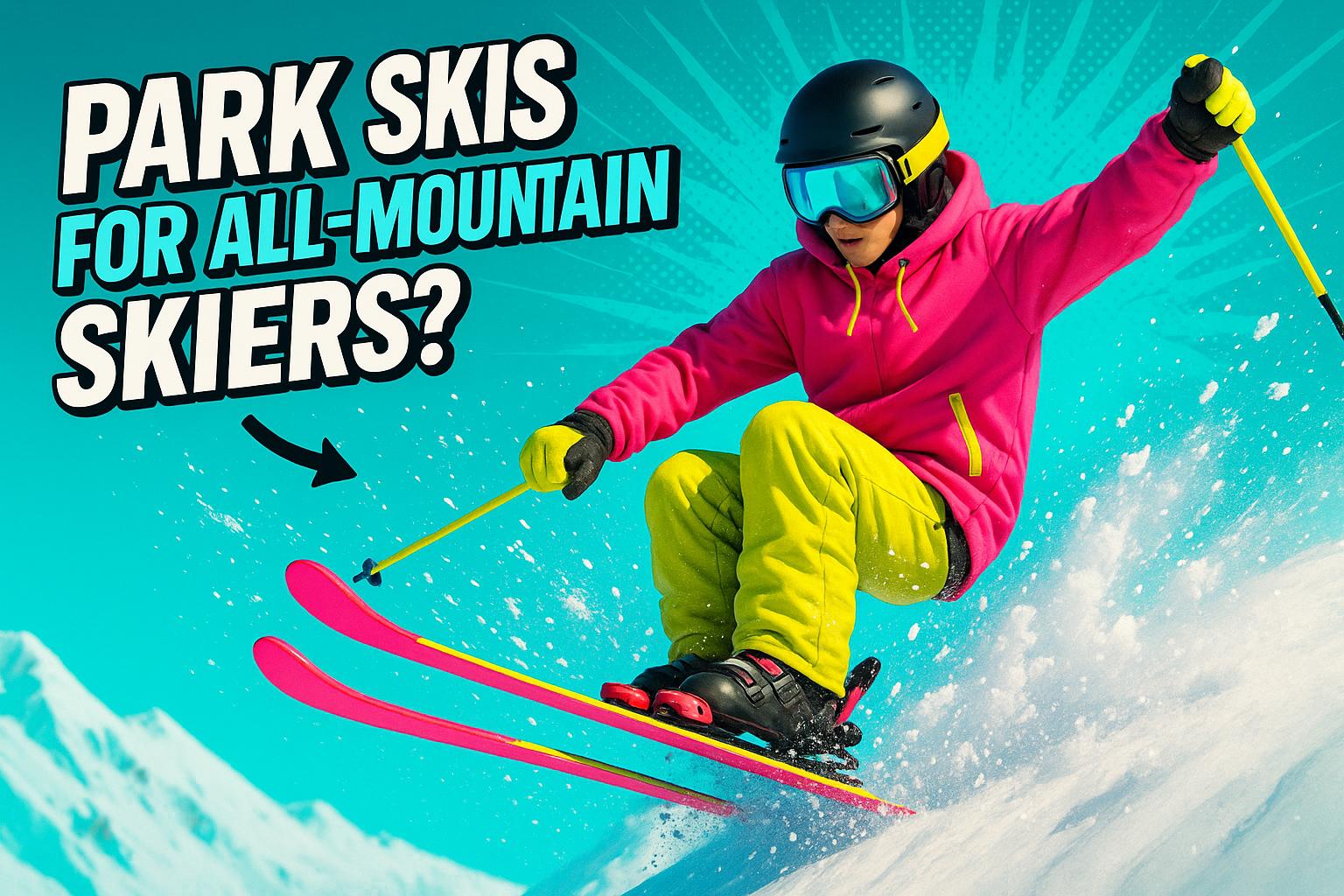




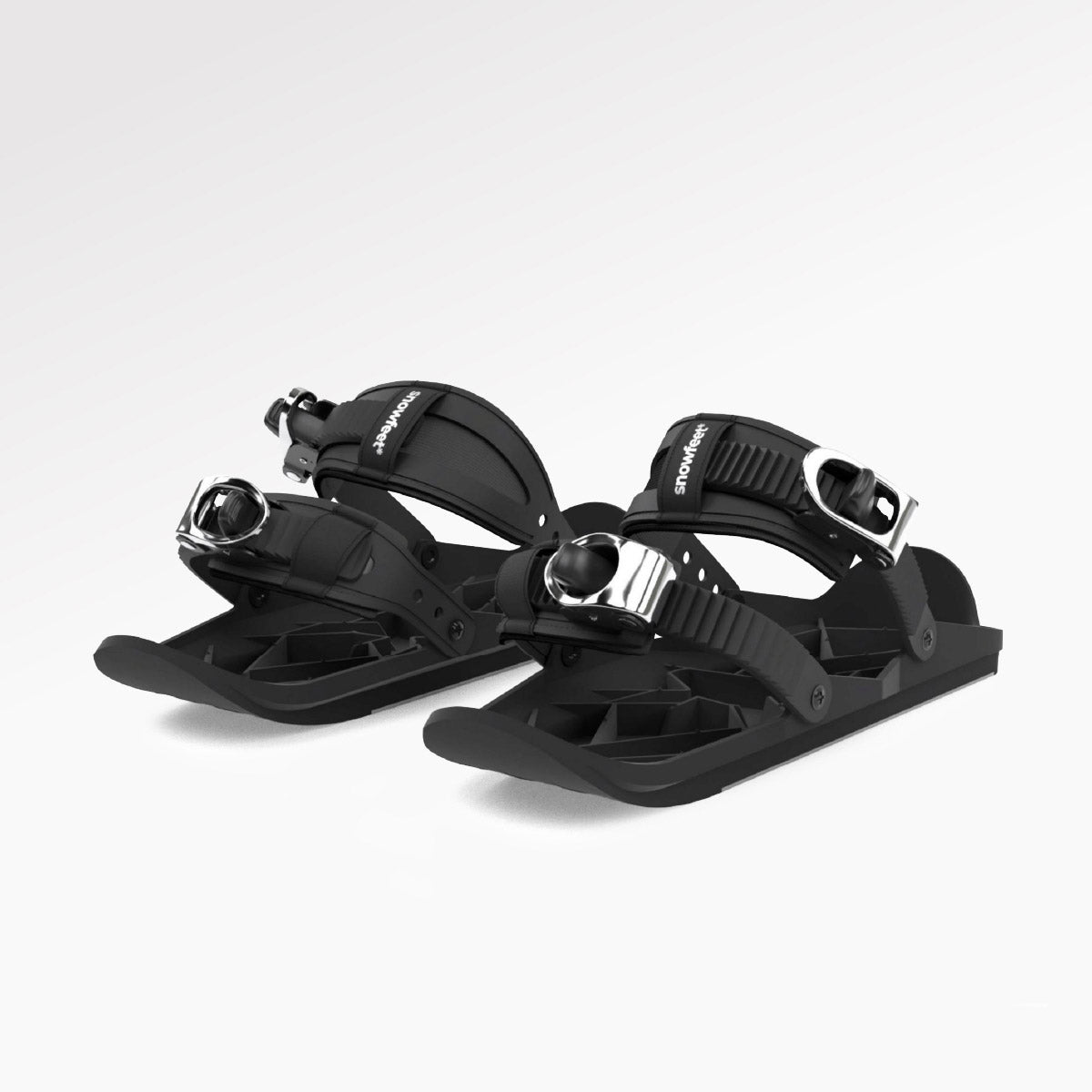
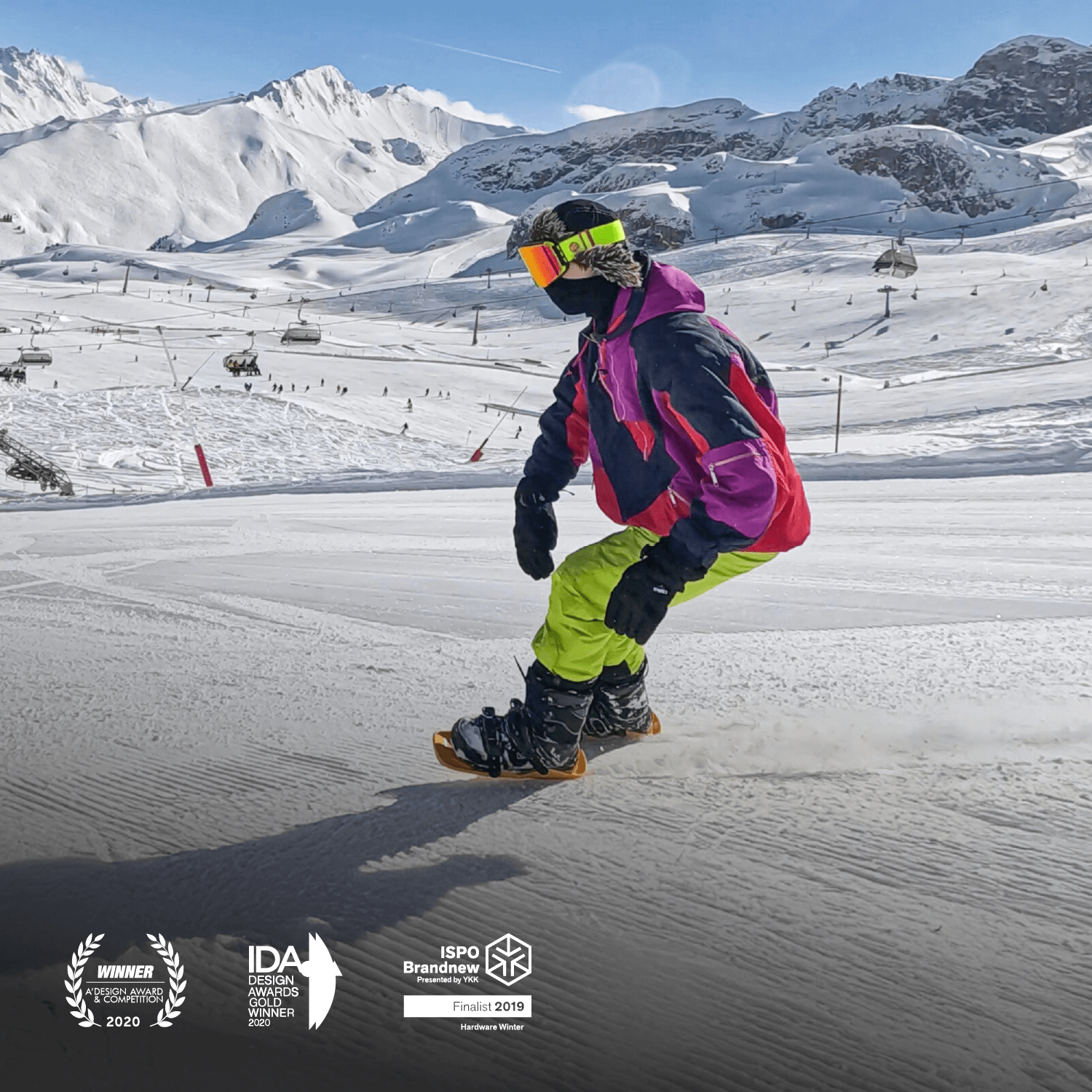




Leave a comment
This site is protected by hCaptcha and the hCaptcha Privacy Policy and Terms of Service apply.